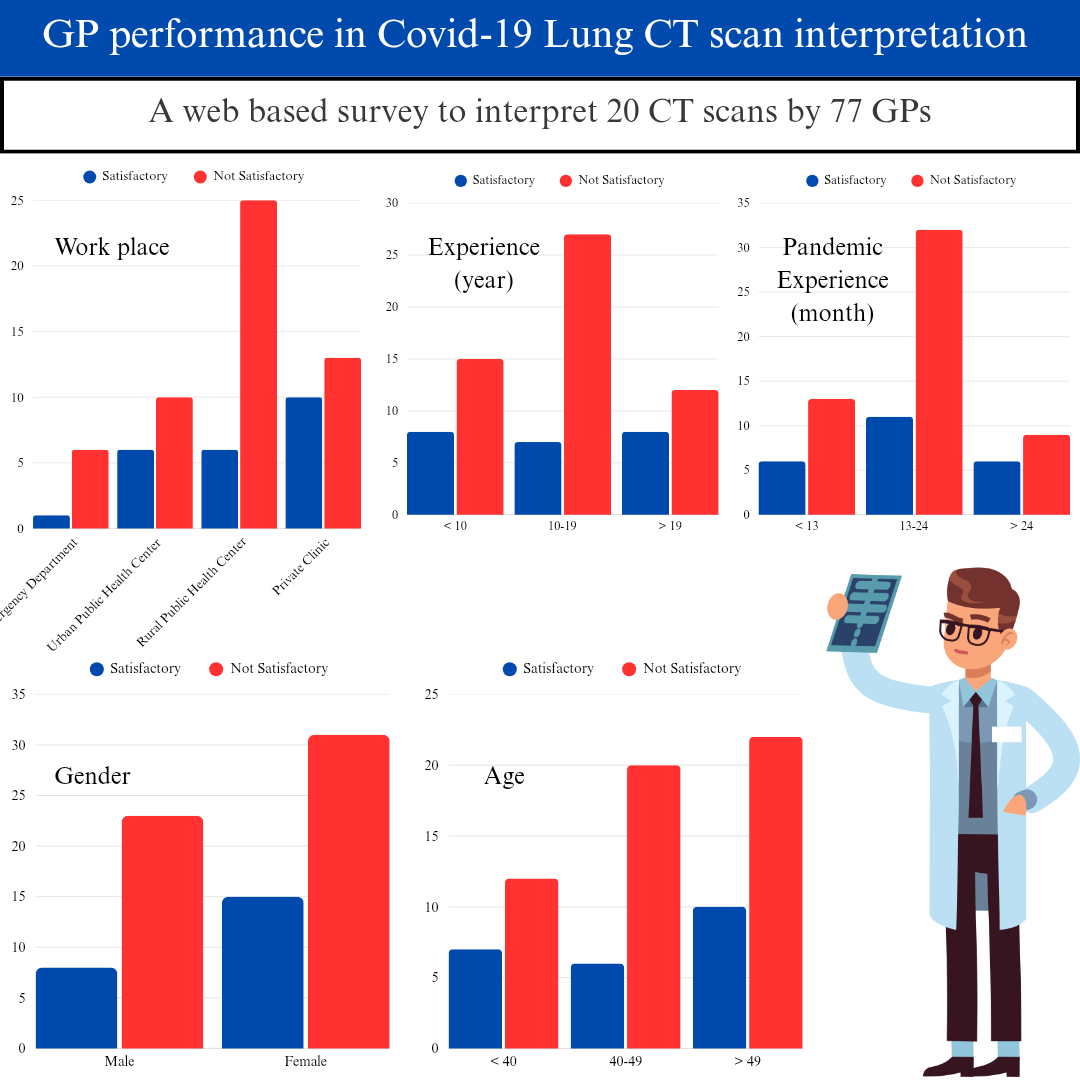Volume 35, Issue 247 (8-2025)
J Mazandaran Univ Med Sci 2025, 35(247): 136-141 |
Back to browse issues page
Download citation:
BibTeX | RIS | EndNote | Medlars | ProCite | Reference Manager | RefWorks
Send citation to:



BibTeX | RIS | EndNote | Medlars | ProCite | Reference Manager | RefWorks
Send citation to:
Moosazadeh M, Shokoohy F, Majidi H, Yazdirad B, Alitaleshi B, Heidari K, et al . Evaluation of General Practitioners' Diagnostic Accuracy in Interpreting Lung CT Scans of COVID-19 Patients: A Cross-Sectional Study in Sari, 2021. J Mazandaran Univ Med Sci 2025; 35 (247) :136-141
URL: http://jmums.mazums.ac.ir/article-1-21899-en.html
URL: http://jmums.mazums.ac.ir/article-1-21899-en.html
Mahmood Moosazadeh 
 , Fatemeh Shokoohy
, Fatemeh Shokoohy 
 , Hadi Majidi
, Hadi Majidi 
 , Behnoush Yazdirad
, Behnoush Yazdirad 
 , Babak Alitaleshi
, Babak Alitaleshi 
 , Keyvan Heidari
, Keyvan Heidari 
 , Mobina Gheibi
, Mobina Gheibi 
 , Erfan Ghadirzadeh
, Erfan Ghadirzadeh 


 , Fatemeh Shokoohy
, Fatemeh Shokoohy 
 , Hadi Majidi
, Hadi Majidi 
 , Behnoush Yazdirad
, Behnoush Yazdirad 
 , Babak Alitaleshi
, Babak Alitaleshi 
 , Keyvan Heidari
, Keyvan Heidari 
 , Mobina Gheibi
, Mobina Gheibi 
 , Erfan Ghadirzadeh
, Erfan Ghadirzadeh 

Abstract: (74 Views)
Background and purpose: In primary care settings, general practitioners (GPs) are often the first point of contact for patients presenting with symptoms suggestive of COVID-19. Interpretation of computed tomography (CT) scans requires prior expertise in reading these images; however, the preparedness and accuracy of GPs in interpreting CT scans have not been previously investigated. Therefore, this study aimed to evaluate the performance of GPs in assessing COVID-19-related CT scans.
Materials and methods: In this cross-sectional study conducted in 2021, using a web-based platform, 77 GPs were presented with 20 lung CT scans, selected by a radiologist to represent varying levels of pulmonary involvement. A checklist including demographic variables and variables related to lung scan findings was utilized for data collection.
Results: While the majority of GPs (84.4%) demonstrated acceptable performance in interpreting CT scans with either very severe involvement or normal findings, this rate decreased significantly to 14.3% and 11.7% for scans with moderate and severe involvement, respectively. Furthermore, younger GPs (<40 years) performed better compared to those over 49 years (36.8% vs. 31.3%), GPs working in private clinics (43.5%) outperformed their counterparts in emergency departments or urban/rural governmental centers. GPs with longer work experience (>19 years), and those with more work experience during the pandemic (>24 months) also showed better performance (40% in both groups). However, none of these differences were statistically significant.
Conclusion: GPs are more successful in identifying normal cases and severe disease, which typically present with clearer radiological signs or no symptoms, but face challenges in diagnosing cases with moderate involvement, which may require greater precision and experience.
Materials and methods: In this cross-sectional study conducted in 2021, using a web-based platform, 77 GPs were presented with 20 lung CT scans, selected by a radiologist to represent varying levels of pulmonary involvement. A checklist including demographic variables and variables related to lung scan findings was utilized for data collection.
Results: While the majority of GPs (84.4%) demonstrated acceptable performance in interpreting CT scans with either very severe involvement or normal findings, this rate decreased significantly to 14.3% and 11.7% for scans with moderate and severe involvement, respectively. Furthermore, younger GPs (<40 years) performed better compared to those over 49 years (36.8% vs. 31.3%), GPs working in private clinics (43.5%) outperformed their counterparts in emergency departments or urban/rural governmental centers. GPs with longer work experience (>19 years), and those with more work experience during the pandemic (>24 months) also showed better performance (40% in both groups). However, none of these differences were statistically significant.
Conclusion: GPs are more successful in identifying normal cases and severe disease, which typically present with clearer radiological signs or no symptoms, but face challenges in diagnosing cases with moderate involvement, which may require greater precision and experience.
Type of Study: Brief Report |
Subject:
general practitioner
| Rights and permissions | |
 |
This work is licensed under a Creative Commons Attribution-NonCommercial 4.0 International License. |





